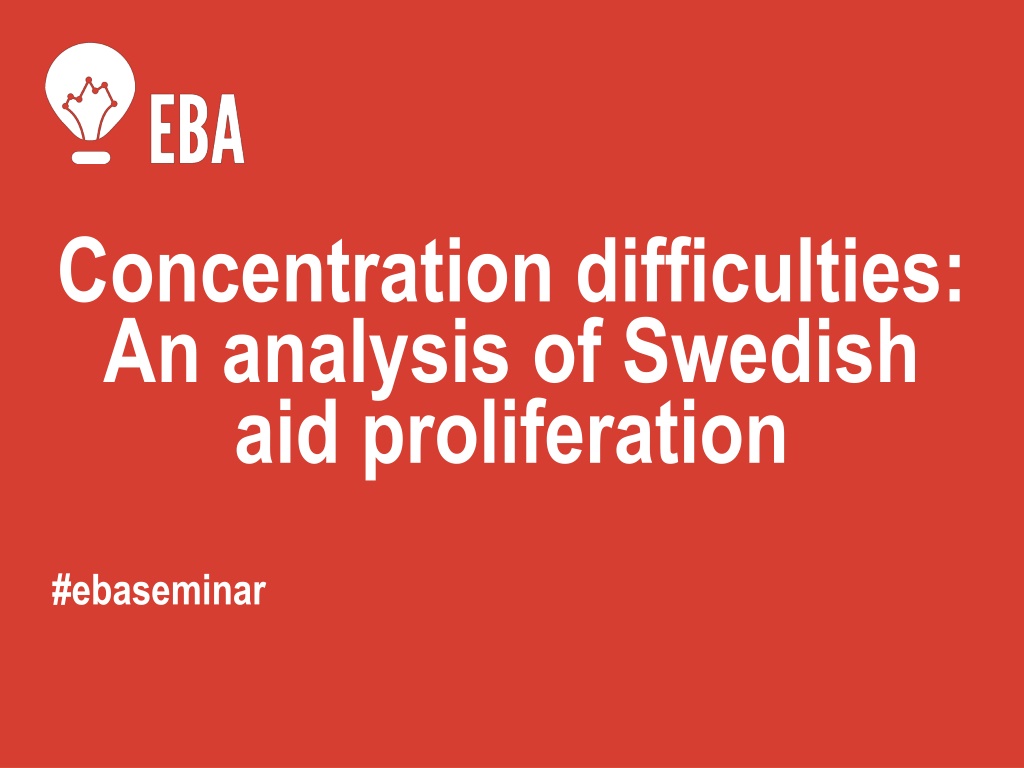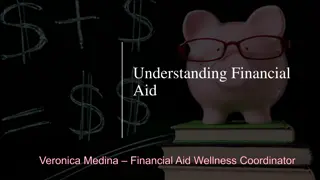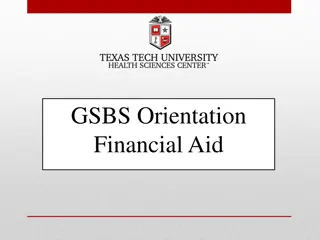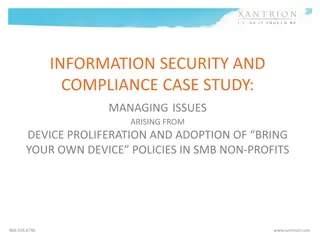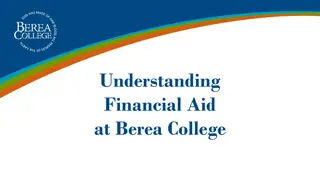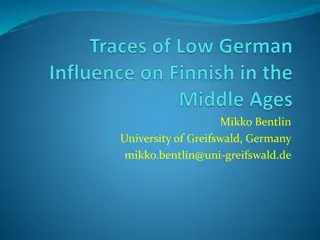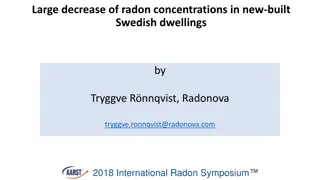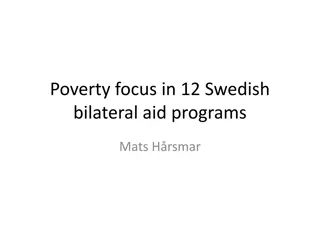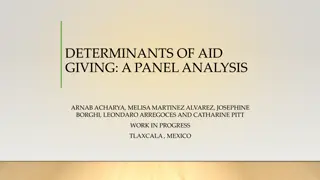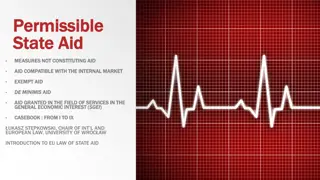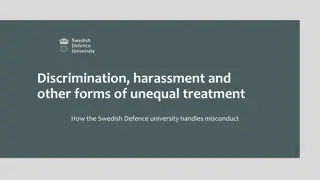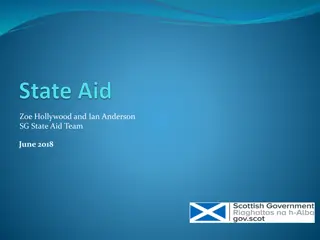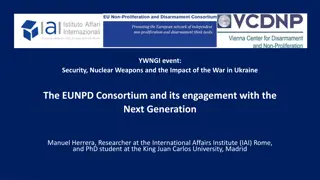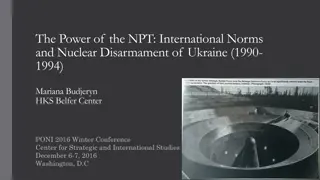Understanding Swedish Aid Proliferation: Challenges and Solutions
Delve into the complexities of aid dispersion in Sweden, analyzing the impact on efficiency and growth. Get insights on measuring aid dispersion, coordination vs. cooperation, and strategies to reduce costs. Explore why aid dispersion is a problem, the importance of concentration, and the need for effective implementation to enhance development effectiveness.
Download Presentation

Please find below an Image/Link to download the presentation.
The content on the website is provided AS IS for your information and personal use only. It may not be sold, licensed, or shared on other websites without obtaining consent from the author. Download presentation by click this link. If you encounter any issues during the download, it is possible that the publisher has removed the file from their server.
E N D
Presentation Transcript
Concentration difficulties: An analysis of Swedish aid proliferation #ebaseminar
Concentration difficulties? An analysis of Swedish aid proliferation RUNE JANSEN HAGEN UNIVERSITY OF BERGEN EBA-SEMINAR AUGUST 20, 2015
Overview Background Why is aid dispersion a problem? Measuring aid dispersion Aid dispersion: The case of Sweden Selectivity in concentration Coordination vs. Cooperation in aid Conclusions
Background High level (Paris) agenda on aid effectiveness Many sensible ideas Implementation disappointing And new emphasis on development effectiveness, which is unlikely to improve the record Major item on that agenda: aid dispersion too high Two ways of reducing costs of aid dispersion Unilateral (e.g. concentration policies of Sweden and others) Simple and lowers costs for both donors and recipients Joint action: coordination vs. Cooperation Coordination costly and becoming costlier with entry of new actors
Why is aid dispersion a problem? Transaction costs Resources absorbed in planning, monitoring, reporting, and evaluating performance in aid-financed activities Incentive problems Free-riding in provision of collective goods and excessive use of common pool resources Transaction costs and inefficiencies caused by incentive problems hard to measure Aid dispersion can be measured and donors have committed to reducing it Fragmentation lowers growth in recipients
Measuring aid dispersion Many measures in literature, some ad-hoc Theil index has well-known properties And a major advantage: it is decomposable Total Theil = Between Theil + Within Theil Between Theil: across partner countries Within Theil: across sectors within recipients Note 1: inequality measure; measures concentration Note 2: normalised to 0 (lowest) 1 (highest) Note 3: first time property applied to aid data
Number of recipients Sweden: Number of recipients up over 2007-2013
Total Theil, Sweden, full sample 2007: Policy change .5 .4 .3 .2 .1 0 1998 2003 2008 2013 Years Overall Between Within Source: Author's calculations Improvement 2007-09 due to between; slippage post 2009; overall no change 07-13
Restricted samples, Sweden 2007: Policy change .5 Only large commitments (left), NGOs excluded (below) .4 .3 .2 .1 2007: Policy change .6 0 .5 1998 2003 2008 2013 Years .4 Overall Between Within .3 Source: Author's calculations .2 Concentration higher, both sub-samples: Small commitments, aid through NGOs more dispersed Improvement 2007-13, due to between Higher dispersion after 2009 .1 0 1998 2003 2008 2013 Years Overall Between Within Source: Author's calculations
Selectivity in concentration: the argument Estimated relationship between institutional quality and income Eligible, selected as potential partners because of higher than expected institutional quality Institutional quality Ineligible due to high incomes Eligible, but not selected as institutional quality is lower than expected X Ineligible due to low institutional quality Z Income level Institutions matter for long-run development Policies can ignite growth, but good institutions needed to sustain it The right institutions and policies are country-specific Different approaches needed in different partner countries Medium-term, country-specific selectivity using mainly budget support can incentivise elites, reduce herding, and lower transaction costs
Swedish selectivity 1: Focus countries 100 Percent 50 0 1998 1999 2000 2001 2002 2003 2004 2005 2006 2007 2008 2009 2010 2011 2012 2013 Focus countries Other countries Source: Author's calculations
Swedish selectivity 2: Income & governance 100 Income (left) and governance (below) Percent 50 .3 0 1998 1999 2000 2001 2002 2003 2004 2005 2006 2007 2008 2009 2010 2011 2012 2013 .2 Low Income Countries Middle Income Countries Source: Author's calculations .1 0 1998 2003 2008 2013 Years Source: Author's calculations Share of Swedish aid to countries in upper 25 percentil of average WGI-indicator
Cooperation vs. coordination Coordination is important because so little cooperation takes place. Large numbers of donors, each doing their own thing in developing countries, give rise to a need for coordination to ensure that all of these activities take place in harmony. Woods (2011, p. 118) Little evidence of Sweden contributing to an improved division of labour among donors Overlap in activities increasing Continuous entry of new actors implies coordination costs will increase, arguably making multilateral aid best complement to unilateral action Sweden s multilateral aid share average as commonly defined
Conclusions Sweden has made international commitments to reducing aid dispersion and adopted its own concentration policy in 2007 Succeeded 2007-2009, slippage afterwards Overall dispersion only lower at sample end if small transactions or NGOs left out Original guidelines no tool for achieving concentration and current aid policy framework does not even mention it Political economy of aid implies policy should be transparent and institutionalised
Commitments, Sweden Average commitmentsize in US dollar millions 2 1500 No of new commitments 1000 1 500 0 0 1998 2003 2008 2013 Years Commitment size No of new commitments Source: Author's calculations
Commitments, DAC Average commitmentsize in US dollar millions 2 75000 Total no of new commitments 50000 1 25000 0 0 1998 2003 2008 2013 Years Commitmentsize No of new commitments Source: Author's calculations
Total Theil, Sweden and comparators .6 .4 .2 0 1998 2003 2008 2013 Years Norway DAC-donors Denmark Sweden United Kingdom Source: Author's calculations
Between-component of Theil .4 .3 .2 .1 0 1998 2003 2008 2013 Years Norway DAC-donors Denmark Sweden United Kingdom Source: Author's calculations
Within-component of Theil .4 .3 .2 .1 0 1998 2003 2008 2013 Years Norway DAC-donors Denmark Sweden United Kingdom Source: Author's calculations
Number of recipients, large commitments 2007: Policy change 100 50 0 1998 2003 2008 2013 Years Norway DAC-donors Denmark Sweden United Kingdom Source: Author's calculations
Sweden, commitments over 500 000 USD Average commitmentsize in US dollar millions 5 400 4 No of new commitments 300 3 200 2 100 1 0 0 1998 2003 2008 2013 Years Commitmentsize No of new commitments Source: Author's calculations
Theil, commitments over 500 000 USD .6 .4 .2 0 1998 2003 2008 2013 Years Norway DAC-donors Denmark Sweden United Kingdom Source: Author's calculations
Number of recipient countries, excluding NGOs 2007: 150 Policy change 100 50 0 1998 2003 2008 2013 Years Norway DAC-donors Denmark Sweden United Kingdom Source: Author's calculations
Commitments Sweden, NGOs excluded Average commitmentsize in US dollar millions 4 1000 No of new commitments 800 3 600 2 400 1 200 0 0 1998 2003 2008 2013 Years Commitmentsize No of new commitments Source: Author's calculations
Theil, NGOs excluded 2007: policy change .6 .4 .2 0 1998 2003 2008 2013 Years Norway DAC-donors Denmark Sweden United Kingdom Source: Author's calculations
Theil Sweden with and w.o. 3 yrs moving average 2007: Policy change .5 .4 .3 .2 .1 0 1998 2003 2008 2013 Years Overall MA Overall Between MA Between Within MA Within Source: Author's calculations
Overlap in activities among donors .2 .1 0 1998 2003 2008 2013 Years Norway DAC-donors Denmark Sweden United Kingdom Source: Author's calculations Average bilateral overlap with other DAC donors: 0 (lowest) 1 (highest)
Average bilateral overlap for Sweden, 1998-2013 Donor Overlap Korea 0.016 Japan 0.052 France 0.068 Australia 0.071 Austria 0.086 Spain 0.105 Italy 0.107 Belgium 0.115 Germany 0.128 Denmark 0.142 USA 0.144 Canada 0.144 Switzerland 0.145 United Kingdom 0.150 Ireland 0.164 Finland 0.172 Netherlands 0.206 Norway 0.241
Overlap, commitments over 500 000 USD .2 .1 0 1998 2003 2008 2013 Years Norway DAC-donors Denmark Sweden United Kingdom Source: Author's calculations
Overlap, excluding NGO-transactions .2 .1 0 1998 2003 2008 2013 Years Norway DAC-donors Denmark Sweden United Kingdom Source: Author's calculations
Donors included and excluded from sample Included Excluded (less than 1% of total observations) Australia Czech Republic Austria Greece Belgium Iceland Canada Luxembourg Denmark New Zealand Finland Portugal France Slovenia Germany United Arab Emirates Ireland Italy Japan Korea Netherlands Norway Spain Sweden Switzerland United Kingdom United States
Sectors in sample DAC5 code 110 120 130 140 150 160 210 220 230 240 250 310 320 Number of observations 128,293 59,920 28,622 29,905 145,768 64,085 11,929 14,949 13,218 9,472 12,009 64,632 23,302 Sector Education Health Population policies/programmes and reproductive health Water and sanitation Government and civil society Other social infrastructure and services Transport and storage Communications Energy generation and supply Banking and financial services Business and other services Agriculture, forestry, fishing Industry, mineral resources and mining, construction Trade policy and regulations and trade-related adjustment, Tourism General environmental protection Other multisector General budget support Developmental food aid/Food security assistance Other commodity assistance Action relating to debt 330 11,727 410 430 510 520 530 600 Total 31,025 77,124 1,739 20,235 436 4,566 752,956
Sectors excluded from sample DAC5 code Sector No of observations 720 VIII.1. Emergency Response 85,727 730 VIII.2. Reconstruction Relief & Rehabilitation 7,931 740 VIII.3. Disaster Prevention & Preparedness 5,070 910 Administrative Costs of Donors 12,297 930 Refugees in Donor Countries 5,654 998 IX. Unallocated / Unspecified 121,954
Theil Formula ???????+ ??? ??? ?? ???= ??? ???? 1? ? = ?=1 ?????? + ????? 1? ? ? ?=1 ???? ?=1 ??????? ? ? = ???? + ?=1 ?=1 ????????????
Kommentarer Eva Lithman
Paneldiskussion Gun-Britt Andersson Hanna Hellquist Staffan Herrstr m
